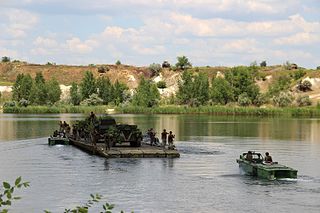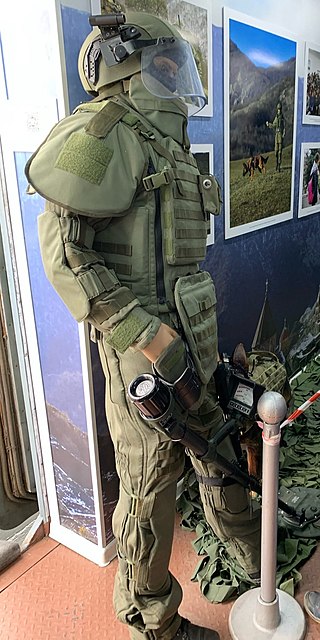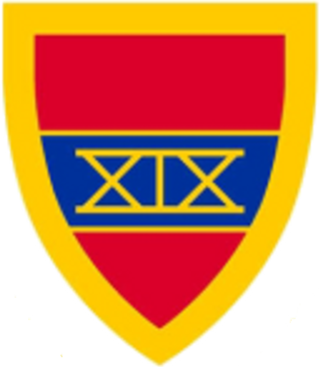
A military engineering vehicle is a vehicle built for construction work or for the transportation of combat engineers on the battlefield. These vehicles may be modified civilian equipment or purpose-built military vehicles. The first appearance of such vehicles coincided with the appearance of the first tanks, these vehicles were modified Mark V tanks for bridging and mine clearance. Modern military engineering vehicles are expected to fulfill numerous roles such as; bulldozer, crane, grader, excavator, dump truck, breaching vehicle, bridging vehicle, military ferry, amphibious crossing vehicle, and combat engineer section carrier.

Military engineering is loosely defined as the art, science, and practice of designing and building military works and maintaining lines of military transport and military communications. Military engineers are also responsible for logistics behind military tactics. Modern military engineering differs from civil engineering. In the 20th and 21st centuries, military engineering also includes CBRN defense and other engineering disciplines such as mechanical and electrical engineering techniques.

A sapper, also called a combat engineer, is a combatant or soldier who performs a variety of military engineering duties, such as breaching fortifications, demolitions, bridge-building, laying or clearing minefields, preparing field defenses, and road and airfield construction and repair.

A combat engineer is a type of soldier who performs military engineering tasks in support of land forces combat operations. Combat engineers perform a variety of military engineering, tunnel and mine warfare tasks, as well as construction and demolition duties in and out of combat zones.

The Irish Army is the land component of the Defence Forces of Ireland. The Irish Army has an active establishment of 7,520, and a reserve establishment of 3,869. Like other components of the Defence Forces, the Irish Army has struggled to maintain strength and as of April 2023 has only 6,322 active personnel, and 1,382 reserve personnel. The Irish Army is organised into two brigades.

The Army Ranger Wing (ARW) is the special operations force of the Irish Defence Forces, the military of Ireland. In late 2023, it was reported that the unit was to be renamed the Ireland Special Operations Force (IRL-SOF). It is a branch of the Irish Army, it also selects personnel from the Naval Service and Air Corps. It serves at the behest of the Defence Forces and Government of Ireland, operating internally and overseas, and reports directly to the Chief of Staff. The ARW was established in 1980 with the primary role of counter terrorism and evolved to both special operations and counter-terrorism roles from 2000 after the end of conflict in Northern Ireland. The unit is based in the Curragh Camp, County Kildare. The 2015 White Paper on Defence announced that the strength of the ARW would be considerably increased due to operational requirements at home and overseas.

Hobart's Funnies is the nickname given to a number of specialist armoured fighting vehicles derived from tanks operated during the Second World War by units of the 79th Armoured Division of the British Army or by specialists from the Royal Engineers.

The Corps of Royal New Zealand Engineers is the administrative corps of the New Zealand Army responsible for military engineering. The role of the Engineers is to assist in maintaining friendly forces' mobility, deny freedom of movement to the enemy, and provide general engineering support. The corps has been involved in numerous conflicts over the course of its history including World War I, World War II, the Korean War, the Vietnam War and the war in Afghanistan. The corps consists of a single regiment, 2nd Engineer Regiment, primarily based at Linton Military Camp near Palmerston North.

A mine flail is a vehicle-mounted device that makes a safe path through a minefield by deliberately detonating land mines in front of the vehicle that carries it. They were first used by the British during World War II.

The Canadian Military Engineers is the military engineering personnel branch of the Canadian Armed Forces. The members of the branch that wear army uniform comprise the Corps of Royal Canadian Engineers.

The Communications and Information Services Corps (CIS) – formerly the Army Corps of Signals – is one of the combat support corps of the Irish Defence Forces, the military of Ireland. It is responsible for the installation, maintenance and operation of communications and information systems for the command, control and administration of the Defence Forces, and the facilitation of accurate, real-time sharing of intelligence between the Army, Naval Service and Air Corps branches at home and overseas.

The Royal Australian Engineers (RAE) is the military engineering corps of the Australian Army. The RAE is ranked fourth in seniority of the corps of the Australian Army, behind the Staff Cadets, Armoured and Artillery Corps. The corps was formed by the amalgamation of the various colonial engineer corps of the states and territories of Australia in 1902 and since then has served in various conflicts including World War I, World War II and the Vietnam War. The corps has also served on numerous peacekeeping operations and was heavily involved in the Australian contribution to the war in Afghanistan.

The Aardvark AMCS Mk4 is a British-made mine flail vehicle built by Aardvark Clear Mine Ltd of Dumfries, Scotland.

The Kent Fortress Royal Engineers (KFRE) was a volunteer Territorial unit of the British Army that saw service in both World Wars. They are notable for their successful actions in May 1940, when they destroyed substantial oil stocks and installations just ahead of the German advance, and in August 1944 during the assault crossing of the River Seine.
37 Field Squadron is a sub-unit of the British Army's Royal Engineers. The squadron is commanded by 32 Engineer Regiment and provides close support engineering to the 4th Infantry Brigade. It is located in Marne Barracks, Catterick and has a long history.
MineWolf Systems provides machines and services for the mechanical clearance of landmines and other explosive devices. Its customers are mine clearance agencies in the commercial, humanitarian and military demining field. British company Pearson Engineering Ltd, a leading provider of Combat Engineer equipment, announced acquisition of the IP and Assets of MineWolf Systems in 2016.

The Umkhonto Field Engineer Regiment is a regiment of the South African Army Engineer Formation. The unit is based in Durban with the HQ being at Old Fort Military Base, Lord's Grounds. As a reserve unit, it has a status roughly equivalent to that of a British Army Reserve or United States Army National Guard unit.

The 1st Devonshire Engineer Volunteer Corps, later the Devonshire Fortress Royal Engineers, was a volunteer unit of Britain's Royal Engineers whose history dated back to 1862. The unit helped to defend the vital naval base of Plymouth, and supplied detachments for service in the field in both World Wars. During the North African campaign in the Second World War, the unit's sappers distinguished themselves in bridging the Nile and clearing minefields during and after the Second Battle of El Alamein. Their successors served on the postwar Territorial Army until 1969.
This article represents the structure of the Irish Defence Forces as of May 2020:
























